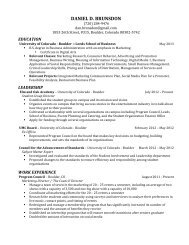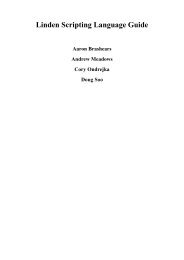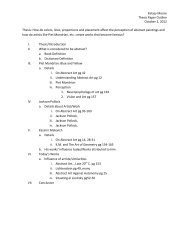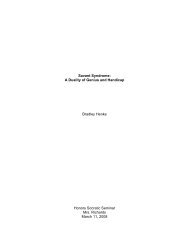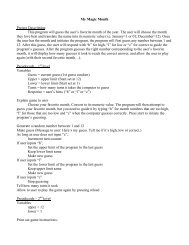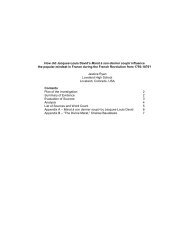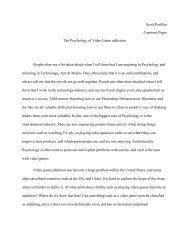Jessica Ryan - University of Colorado Boulder
Jessica Ryan - University of Colorado Boulder
Jessica Ryan - University of Colorado Boulder
- No tags were found...
Create successful ePaper yourself
Turn your PDF publications into a flip-book with our unique Google optimized e-Paper software.
<strong>Ryan</strong> 1<strong>Jessica</strong> <strong>Ryan</strong>HONR 1810KeasleyProblem-Posing Education Paper30 November 2009Gay Males Coming to Know their Spiritual Identitiesand Learning to Reconcile The Sexual and SpiritualTraditionally, homosexuality has been considered taboo and unacceptable inmany religions. However, homosexuals continue to identify themselves as religious orspiritual, in spite <strong>of</strong> the stigma placed on them. The strategies gay males employ in orderto come to know their spiritual identities, as well as to reconcile their spiritual and sexualidentities, follow many <strong>of</strong> the epistemological suggestions <strong>of</strong> Paolo Freire, Mary LouisePratt, Gerard Hauser, R. G. Billingsley, and bell hooks.In coming to know their spiritual identities, along with reconciling the spiritualand sexual, gay males must learn how to consciously work with their experiences. PaoloFreire, in “The Banking Concept <strong>of</strong> Education: Problem-posing and Banking Concept,”employs the use <strong>of</strong> a Portuguese term, conscientizaçāo, representing a method forknowers (specifically students) to undermine oppression and to become “beings forthemselves” (Freire 210). Conscientizaçāo is a complex concept, translated as “learningto perceive social, political, and economic contradictions, and to take action against theoppressive elements <strong>of</strong> reality” (Freire 210). This consciousness is fundamental toFreire’s theory; he advocates “problem-posing education,” which is defined as“responding to the essence <strong>of</strong> consciousness” (Freire 213).Andrew K. T. Yip, in “Attacking the Attacker : Gay Christians Talk Back,”describes strategies for managing stigmas associated with being a gay Christian. One
<strong>Ryan</strong> 2such strategy is labelled “discrediting the Church.” Yip writes, “This strategy has a strongsocio-cultural relativity emphasis, thus treating the Bible as a product <strong>of</strong> its time and mustbe interpreted in the light <strong>of</strong> changing social realities, without disrespecting its authority”(119). Yip’s account shows gay Christians in full practice <strong>of</strong> conscientizaçāo. In order tosuccessfully use this strategy to reconcile their spiritual and sexual identities, they mustfirst learn to become conscious <strong>of</strong> the contradictions present in their experiences.Secondly, they must take action against the contradictions, in this case, interpreting theBible in terms <strong>of</strong> its historical context instead <strong>of</strong> literally.James A. Cates writes that developing a homosexual identity is a “phase-basedprocess by which the individual recognizes and accepts homosexual feelings andidentity” in his article, “Identity in Crisis: Spirituality and Homosexuality inAdolescence” (370). Becoming conscious <strong>of</strong> homosexual feelings is essential to forminga sexual identity. By learning to accept such feelings, gay males can begin to feelconfident in their sexual identities and begin reconciling them with other identities.Although a high suicide rate exists for gay adolescents, “research also suggests aresilience in self-esteem” which “may relate to the relief <strong>of</strong> openly expressing an identityor finding a support group” (Cates 371).Because homosexuality is generally not accepted in religious communities(progressive ministries accepting <strong>of</strong> homosexuality are indeed growing in popularity),gay males learning to form a spiritual identity <strong>of</strong>ten enter what Mary Louise Pratt callsthe “contact zone.” In her paper, “Arts <strong>of</strong> the Contact Zone,” Pratt describes one <strong>of</strong> herclassrooms as a contact zone. For her, a contact zone is an area in which a group <strong>of</strong>people converges ; this group must represent a broad spectrum <strong>of</strong> ideas, opinions, and
<strong>Ryan</strong> 3backgrounds (454). From her experiences, Pratt concludes the value contact zones hold isimmense, as they allow for multi-layered discussion and debate, creating a moremeaningful discourse. Pratt also discusses the importance <strong>of</strong> language in her article,writing, “Many commentators have pointed out how modern views <strong>of</strong> language as codeand competence assume a unified and homogenous social world in which language existsas a shared patrimony” (451).Yip describes how gay Christians make use <strong>of</strong> language in order to learn tosurvive life in the contact zone, challenging the “homogenous social world” created bythe authorities <strong>of</strong> their religion:In their relationships with the Church, gay Christians are subjected to theChurch's vocabulary <strong>of</strong> motives that labels their lifestyle as unacceptable.In response, gay Christians have to develop an alternative vocabulary <strong>of</strong>moral motives that label their sexuality and lifestyle as compatible withChristianity. Needless to say, the Church's <strong>of</strong>ficial stance onhomosexuality generates a stigmatizing climate under which gayChristians must learn to survive. (116).While Yip does not elaborate on the specifics <strong>of</strong> this “alternative vocabulary,” he doeslater discuss alternative interpretations <strong>of</strong> spiritual texts, like the aforementionedconscientizaçāo treatment <strong>of</strong> the Bible. Yip also discusses the difference between Biblicaland Christian principles : “Biblical principles are founded on the literal words <strong>of</strong> theBible without taking, inter alia, contextualization into consideration… On the contrary,Christian principles are broad principles derived from values embraced by Christianity.Unconditional love and full acceptance <strong>of</strong> all peoples are two salient examples” (118).
<strong>Ryan</strong> 4The creation <strong>of</strong> an “alternative vocabulary,” therefore, seems more to be based onalternate interpretations <strong>of</strong> language, rather than an entirely new set <strong>of</strong> language.Nevertheless, manipulating language allows gay Christians to enter the contact zone andlearn to successfully partake in discussions about religion and spirituality.Dawne Moon, in “Discourse, interaction, and testimony: The making <strong>of</strong> selves inthe US Protestant dispute over homosexuality,” writes, “Foucault’s theory <strong>of</strong> powerallows us to consider how those interaction processes are limited by the constraints <strong>of</strong>language” (553). This supports Pratt’s position that language homogenizes a community.However, gay males with a spiritual identity, as well as people who support them, can uselanguage to authenticate their worldview (Moon 565). Moon shares a story <strong>of</strong> herexperience with the pastor <strong>of</strong> a pro-gay congregation, who was <strong>of</strong> the position thathomosexuality is as God-given as heterosexuality. “If people are born gay, then it mustfollow in this language that they cannot and should not change” (Moon 567). In thecontact zone, language can be manipulated by either side in order to further the level andamount <strong>of</strong> discourse taking place.Gay males with a spiritual identity must learn how to balance their subjectivepersonal development and the objectivism <strong>of</strong> religious doctrine. The concepts <strong>of</strong> paideiaand wissenschaft are discussed in Gerald Hauser’s “What’s a Kid From Athens Doing inThe Center <strong>of</strong> Berlin? or Paideia Meets Wissenschaft : A Central Dilemma <strong>of</strong>Contemporary Rhetorical Education.” Hauser defines paideia as “the formation <strong>of</strong> youngstudents by developing their capacity to function as responsible citizens,” relating this toone’s civic duty and character formation (6). Wissenschaft is defined as “orderly,disciplined critical research” that is focused on the “discovery <strong>of</strong> knowledge” instead <strong>of</strong> a
<strong>Ryan</strong> 5student’s individual growth (Hauser 8). While these two concepts contrast each other ingoals, Hauser advocates an education system in which both concepts occur and areconsidered valuable.By coming to know their sexual and spiritual identities, gay males must examinetheir lives and focus on which paths will aid in their personal development. They mustalso learn the impact <strong>of</strong> environmental influences, as research shows siblings, parents,and friends serve “at any age as a continuum from encouragement to discouragement <strong>of</strong>self-acceptance” (Cates 370). These outside influences have the possibility <strong>of</strong> negativelyaffecting the individual, but if he is aware <strong>of</strong> his environment, then he will also beconscious <strong>of</strong> its influence. When both identities have been formed, issues still arise fromcompeting values systems (Cates 379). Religious doctrines are <strong>of</strong>ten treated as objectivemandates from God; thus, gay males following a specific religion (instead <strong>of</strong> simplybeing “spiritual”) must follow the doctrines in order to fully follow that religion.However, when their sexual identities – which are a part <strong>of</strong> their personal development –are forbidden by their religion’s objective policies, gay males are faced with a conflict <strong>of</strong>interest. This conflict is similar to the one described by Hauser: how does one merge thesubjective with the objective?In “Attacking the Attacker,” one strategy gay Christians use in reconciling theirspiritual and sexual identities as recognised by Yip is “attacking the stigma.” Againdrawing on the difference between literal and fairly objective Biblical principles and themore subjective Christian principles, Yip writes, “…broad and general Christianprinciples override the perceived condemnation <strong>of</strong> homosexuality in these passages.These broad principles, such as God's unconditional love for and acceptance <strong>of</strong> all
<strong>Ryan</strong> 6peoples as well as Christian justice, should override the Church's stigmatization <strong>of</strong> gaypeople” (118). Gay Christians, then, must interpret the principles <strong>of</strong> their faith,simultaneously respecting the knowledge put forth by the Bible, following wissenschaft,and also practice paideia by following the Christian principles that lend to individuals’spiritual development. By being aware <strong>of</strong> the workings <strong>of</strong> both paideia and wissenschaft,gay males can nurture both identities simultaneously, empowering them to handleconflicts which may arise from competing value systems.R. G. Billingsley’s article, “Facilitating Discussion,” regards discussion as auseful and essential tool in education. Likewise, discussion plays a key role in aiding gaymales who are learning to reconcile their sexual and spiritual identities. From the selfdiscussionheld in coming to know one’s own sexual and spiritual identities to thediscourse held in the contact zone, gay males with spiritual identities must constantlyengage. In addition to heralding the values <strong>of</strong> discussion, Billingsley also advocates for afocus on the individual. Speaking in the world <strong>of</strong> schools and teachers, Billingsley writes,“Teaching must first, foremost, and always remain focused on students and their growth”(39). Learning is more than simply imparting knowledge; it also requires an emphasis onthe individual and his or her worth. Billingsley believes a key to successful learning isencouragement: “We must demonstrate to students our belief that they can achieve notonly because they are gifted and have unknown talents, but, as people, they are inherentlyvaluable” (41).In coming to know their spiritual identities, gay males <strong>of</strong>ten must engage in selfdiscussion,keeping in mind their inherent value. Yip writes, “Research evidence suggeststhat the religious beliefs <strong>of</strong> the majority <strong>of</strong> gay people demonstrate a form <strong>of</strong>
<strong>Ryan</strong> 7individualized spirituality which emphasizes a personal faith that is broadly andnominally predicted on Christianity, instead <strong>of</strong> seeking affirmation from the Church”(122). While diminishing the possibility <strong>of</strong> discussion in the religion-specific contactzone, selecting an individualized spirituality still allows discussion to take place. Byquestioning himself and turning to others for advice, a gay male can personalize hisspiritual identity such that it properly facilitates his growth while asserting and affirminghis inherent value. Yip also writes <strong>of</strong> gay males’ incorporation <strong>of</strong> Christianity in theirrelationships. A common strategy noted in his research is the success <strong>of</strong> such partnershipswhen taking place within a Christian framework (Yip 122). Many <strong>of</strong> Yip’s respondentsdiscussed praying for their relationships, one even saying “. . . if it is againstChristianity . . . if I prayed to God, I am not going to get help. But I have received help”(Yip 122). That his prayers were answered affirmed the respondent’s belief thathomosexuality and Christianity can be reconciled. Through the respondent’s experience,he was able to come to know a strategy for merging his sexual and spiritual identities.Discussion played a key role in Moon’s research about homosexuality andProtestantism, as she wanted to examine the way people felt about both subjects “as theylived their everyday lives” (558). By attending numerous meetings and group discussionson a variety <strong>of</strong> topics ranging from relationships to church policies, Moon was able toobtain perspectives from different types <strong>of</strong> people. Discussion was also an important partin her subjects’ lives, as well; Moon writes <strong>of</strong> various congregations discussing whetherhomosexuality and Protestantism could be reconciled. While not a dialogue, Moon alsoheralds the value <strong>of</strong> testimony, saying it reveals to oneself and to others certain elements
<strong>Ryan</strong> 8<strong>of</strong> one’s life, leading to a “moment <strong>of</strong> revelation” (559). By explaining to others theimportant parts <strong>of</strong> his life, a gay male can begin and continue to realise his inherent worth.For gay males, coming to know their spiritual identities can be incrediblyliberating, in spite <strong>of</strong> the possible challenges they may face. In “Engaged Pedagogy,” bellhooks advocates a system <strong>of</strong> learning in which the learner is able to become a wellroundedperson and is taught how to live in the world (3-4). Following the teachings <strong>of</strong>Freire and the Buddhist philosopher Thich Nhat Hanh, hooks promotes the idea thatlearning can have libratory effects on an individual. hooks writes <strong>of</strong> Hanh’s view <strong>of</strong> the“teacher as a healer”, saying that in order to receive the benefits <strong>of</strong> knowledge, studentshave to be “active participants, to link awareness with practice” (3). When someone islearning (not just being schooled), they achieve a sense <strong>of</strong> self-actualization andempowerment (hooks 4). hooks’ emphasis on becoming a well-rounded person isimportant, for just as religion and sexuality are not totalities <strong>of</strong> heterosexual life, neitherare they totalities <strong>of</strong> homosexual life. The two identities are indeed important andnecessary in order to be a complete, well-rounded person; however, there is more to lifethan solely religion or sexuality.Gay males’ learning to reconcile their spiritual and sexual identities represents aprime example <strong>of</strong> how learning can be libratory. Kip lists one strategy as “theontogeneric argument,” describing it as the belief that “all sexualities are created,sustained, and blessed by God” (123). The argument follows that because God createdeverything which is good, and God created sexuality, than all sexualities must be good.This belief affirms the goodness <strong>of</strong> homosexuality, allowing gay males to reconcile theirspiritual and sexual selves freely. Yip writes,
<strong>Ryan</strong> 9The thrust <strong>of</strong> the matter is therefore not the nature <strong>of</strong> the sexuality, but themanner in which it is expressed. They are <strong>of</strong> the opinion that, beingChristians, they ought to express their sexuality within a Christian moralframework. Practising it outside <strong>of</strong> this framework constitutes itsunacceptability, but not the intrinsic nature <strong>of</strong> the sexuality itself. (123)In learning <strong>of</strong> and choosing to follow the ontogeneric argument, gay males can findsolace in God’s blessing <strong>of</strong> their sexual identities. Using this argument makes religionand spirituality more accessible for gay males, thus allowing them to develop a spiritualidentity and become better-rounded.Cates writes <strong>of</strong> adolescent gay males coming to terms with their sexual identitiesafter having already established their spiritual identities. In each <strong>of</strong> Cates’ three casestudies, the adolescents in question had exhibited homosexual behavior or thoughts, andin all three cases, conversion therapy was presented as an option. Each boy was placed incounseling; Cates studies the effects <strong>of</strong> their time with psychologists. “Ernest,” an OldOrder Amish boy, revealed homosexual fantasies to his therapist, a practice which wasliberating for him. Because he couldn’t discuss his sexuality with his family or friends,Ernest’s access to a therapist (which was court-ordered do to alcohol and vandalismviolations) provided an outlet for him to share his thoughts (Cates 376). Although therapydidn’t help Ernest accept his own thoughts and behaviors, he did turn out more tolerantand accepting <strong>of</strong> homosexuals than before he started therapy. Having the opportunity tolearn about his feelings and discuss them with someone he trusted liberated Ernest. Cateswrites that therapy left him with “the freedom to discuss such feelings and process them,”and that at the end <strong>of</strong> his therapy sessions, he would lose that freedom (378). Because he
<strong>Ryan</strong> 10was an adolescent already taught that his sexual and spiritual identities could not bereconciled, Ernest sought acceptance through therapy. Although he had exhibitedhomosexual thoughts, Ernest refused to identify himself as gay. Cates writes “anadolescent requires a longer period <strong>of</strong> identity exploration,” which could explain whyErnest continued to think <strong>of</strong> himself as “wicked” despite having gone through therapy(379). However, discussion and learning did in fact liberate him; the therapist’s respect“seemed to provide him with a greater sense <strong>of</strong> comfort than might otherwise have beenthe case” (378). In learning about himself through therapy, Ernest was able to experiencefreedom.Gay males face numerous challenges when coming to know their spiritualidentities and then merging it with their sexual identities. However, pedagogical methodsdescribed by Paolo Freire, Mary Louise Pratt, Gerard Hauser, R. G. Billingsley, and bellhooks are demonstrated as being useful in learning about one’s own identities. Throughthe use <strong>of</strong> these strategies, gay males are able to learn about themselves and their sexualand spiritual identities, developing and reconciling the two while continuing to maketheir lives as successful as possible.
<strong>Ryan</strong> 11Works CitedBillingsley, R.G. “Facilitating Discussion.” Getting Started: Idea Book on Pedagogy forNew Faculty. <strong>University</strong> <strong>of</strong> <strong>Colorado</strong>: <strong>Boulder</strong>. 1998. Print.Cates, James A. "Identity in Crisis: Spirituality and Homosexuality inAdolescence." Child Adolescent Social Work Journal 24 (2007): 369-83. Web. 10Nov. 2009.Freire, Paolo. The Banking Concept <strong>of</strong> Education. 1968. Print.Hauser, Gerard A. “What’s a Kid From Athens Doing in The Center <strong>of</strong> Berlin? or PaideiaMeets Wissenschaft : A Central Dilemma <strong>of</strong> Contemporary RhetoricalEducation.” 2003. Print.hooks, bell. “Engaged Pedagogy.” Teaching to Transgress: Education as the Practice <strong>of</strong>Freedom. New York: Routledge, 1994. Print.Moon, Dawne. "Discourse, Interaction, and Testimony: The Making <strong>of</strong> Selves in the U.S.Protestant Dispute Over Homosexuality." Theory and Society 34.5 (2005): 551-77. JSTOR. Web. 28 Oct. 2009.Pratt, Mary Louise. “Arts <strong>of</strong> the Contact Zone.” Pr<strong>of</strong>essions. 1990. Print.Yip, Andrew K. T. "Attacking the Attacker: Gay Christians Talk Back." The BritishJournal <strong>of</strong> Sociology 48.1 (1997): 113-27.JSTOR. Web. 28 Oct. 2009.



 restaurant"
>
restaurant"
>
